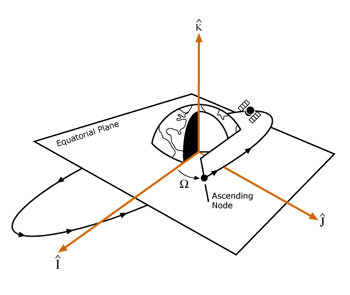Pass Boundaries for Satellites
The Pass Break page of a satellite's Basic properties allows you to indicate the event that defines the boundary between passes (or revolutions) of an orbiting satellite. Most systems specify that a new pass, or orbital revolution, begins when a satellite passes through the inertial equator going north. A pass begins at the ascending node. The following diagram illustrates the ascending node of a satellite's orbit.

A pass break can be defined as the time when the satellite crosses a specified latitude boundary in either the ECF or ECI coordinate system. You can define the pass break by choosing the direction of motion (Ascending or Descending) when the satellite crosses the specified latitude. The default definition of the pass break is 0 degrees latitude in the inertial system on the ascending side of the orbit (the ascending node). The pass (or revolution) definition is a convention that satellite systems use to describe various periodic data.
If the specified latitude crossing is outside the satellite's range of motion, the north point or south point of the orbit is used as the pass break for specified positive or negative latitudes.
Due to the precessional and nutational motion of the Earth's spin axis, the crossing of the ascending node may occur at a time slightly different from the time when the satellite crosses the Earth-fixed equator.
Options for setting pass breaks
| Option | Description |
|---|---|
| Definition | Options are:
|
| Direction | Specify either Descending (moving South) or Ascending (moving North) for the latitude crossing at the beginning of a pass. |
| Coordinate System | Select the coordinate system in which the latitude or longitude should be measured from the drop-down menu; select from Fixed, Inertial, TrueOfDate, or TrueOfOrbitEpoch. |
| Partial Pass Measurement | Indicate the method to be used to measure partial passes (typically used for reporting data):
|
| Repeat Ground Track Numbering | The path number in the repeat ground track cycle corresponding to the initial conditions and the number of revolutions in the repeat cycle. Path numbers are incremented concurrently with pass numbers, but are limited to a range of 1 to the number of revolutions in the repeat cycle. Once the path number reaches the number of revolutions in the repeat cycle, the next path number is 1. Path numbers are also maintained by the Maintain Pass # option.
|
| Pass Numbering | The pass number corresponding to the initial conditions of the satellite. If your new ephemeris start time is after the previous end time (or before the previous start time), STK estimates the pass number of the new start time based on the period of the orbit.
|
Determining the Orientation of Earth's Axis
The exact orientation of the Earth's spin axis is a function of three physical phenomena:
- Precession is a slow rotation (period of 26,000 years) of the spin axis forming a cone about an average spin axis direction.
- Nutation is a shorter period (18.6 years) wobble on top of the precessional motion.
- Pole wander is the motion of the polar axis relative to fixed points on the Earth's surface, and is at least partially unpredictable.
Inertial coordinate systems are typically defined in such a way that the orientation of the spin axis and daily equinox at some point in time account for the effects of precession only (mean), or they account for the effects of both precession and nutation (true).

